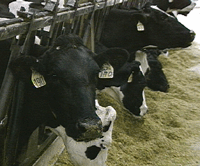Kentucky Dairy Industry Has the Ingredients for Growth
Kentucky Dairy Industry Has the Ingredients for Growth

Fueled by a strong economy, the demand for milk products in the United States reached record levels in 1999. Unfortunately, Kentucky's production declined during this prosperous period and the average production per cow continued to rank among the lowest in the nation.
And the picture may even be bleaker for the Kentucky dairy industry in 2000 according to the latest USDA outlook.
"Nationwide milk production is predicted to exceed 1999 levels," said Leigh Maynard, agricultural marketing research specialist in the University of Kentucky College of Agriculture, "but Kentucky's dairy production will likely decline further, partly in response to expected lower prices but mostly due to exits from the industry."
It is a frustrating situation for people such as Robert Harmon, a dairy scientist and teacher in the UK College of Agriculture, who sees an industry with plenty of upside.
"Kentucky is ideally suited geographically to be a major milk supplier to the region," noted Harmon. "It can be one of the most profitable enterprises in the state if producers maximize the use of our vast resource of high-quality forages that can be grown in this state."
In 1998 Kentucky farm income from milk production was about $266 million. Harmon speculated the state's producers could add another $100 million in additional income with the modernization of the dairy industry and adoption of new technology and management techniques.
"There are a number of hurdles to overcome to increase that bottom line, but none of them are insurmountable," said Bill Crist, Extension dairy specialist in the UK College of Agriculture. "We have the opportunity to produce milk as cheap as anywhere in the country with our forage base."
Many of the same constraints that prevented Kentucky's dairy industry from reaching its potential 10 years ago still plague the industry today.
In a 1991 report on the state's dairy industry, UK researchers and Extension personnel pointed out that farmers were still hesitant to adopt proven practices and technology. Many also were reluctant to learn better management, business and technical skills.
"Growing and then feeding the right kinds of forage is our weakest link," said Crist. "And then comes management of the dairy cattle themselves and the lack of proper housing in general."
Crist added that the face of the industry is changing. The interest in upgrading the dairy operation on existing farms is growing... a trend that seems to be in concert with lower prices and shrinking bases for tobacco crops.
He also has seen the beginning of a move toward more specialization in this industry. "Some producers are growing and harvesting the feed, others are raising the heifers and some are just milking the cows," said Crist. "It will be more of a community arrangement than we have had in the past."
Many in the dairy industry believe one of the keys to speeding up the research and teaching process to meet these new trends and recurring constraints is a modern dairy research center for the Kentucky dairy industry.
A site for just such a facility has been established at the UK Animal Research Center in Woodford County.
"The current transition the dairy industry is experiencing makes the development of this unit paramount in addressing the needs of this rapidly changing industry, " said Harmon.
New facilities would allow for a much safer and more efficient research environment to study such issues as animal health, immunity, milk quality, nutrition and reproduction.
"A state-of-the art building would add excitement to the industry," said Crist. "It would enable us to do more research and it would be much easier to get clients to come in and see what is being developed, which in turn would speed up the teaching and adoption process. "
Funding for the facility is included in a $19 million dollar phase two project request recently submitted by the UK College of Agriculture to the state legislature. It is part of a package that also includes funding requests for a learning center, a feed mill for formulating experimental rations and the completion of the beef research facilities.
Harmon estimated that in about ten years the returns producers could expect from increased support for research and teaching efforts could amount to over $860 per cow. Those profits would be realized from reduced cases of mastitis, increased milk production, improved reproductive performance and improved milk quality.
"In addition to these returns, the potential exists for future development of speciality dairy products including some products that may have additional human health benefits," said Harmon.
"The construction of the facility won't solve all the problems in this industry," added Harmon. "But now is the time to modernize our dairy farms and take advantage of the technology we have at hand."
